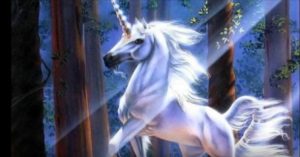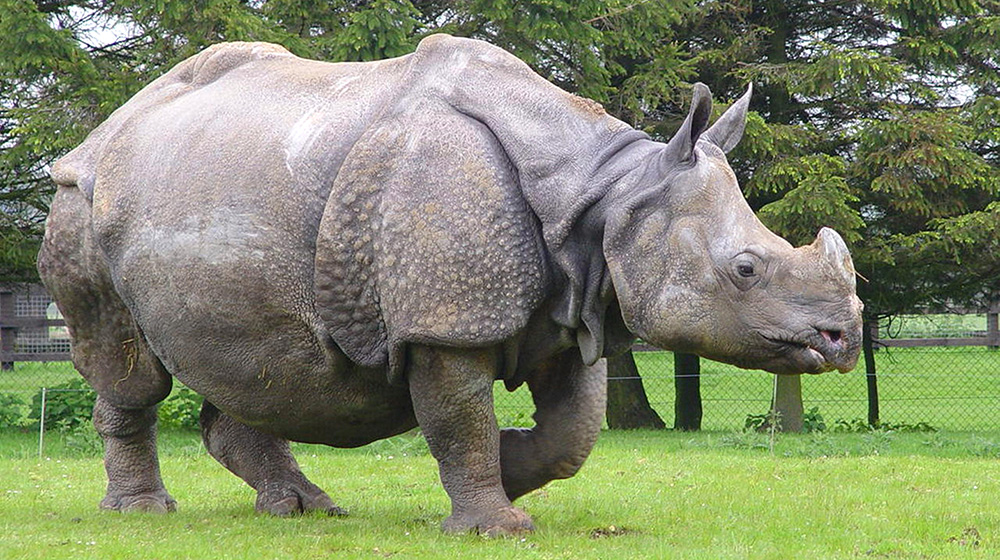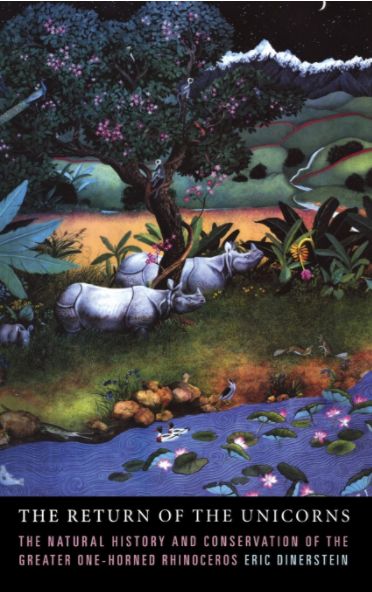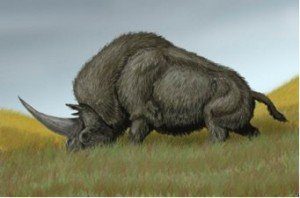Why Does The Bible Mention Unicorns? [Original Title]
By Eric Hovind on July 19, 2011 [creationtoday.org]

If you look up the word “unicorn” in the Webster’s New World Dictionary, it says:
Unicorn – A mythical horse-like animal with a single horn growing from its forehead.
This is what most of us think of when we hear the word unicorn. We think of a horse with a horn growing from its head. This is how unicorns are depicted in movies, cartoons, paintings, etc.
Now, this is not a real creature. This animal is totally fictitious. None of these are alive today and no scientist has ever found a fossil of one. However, unicorns are mentioned in the King James Version of the Bible 9 times, in 5 different books, by at least 5 different people: by Balaam, Moses, David, Isaiah, and even The Eternal himself in the book of Job. These are the verses that mention unicorns in the King James Version:
[In Hebrew the word ‘luck’ or ‘fortune’ is pronounced as «gad» and sometimes as «god» (medieval). This site prefers not to use the word ‘God’ and only uses it when we quote certain writers or when comparing certain versions of Scripture as in this case]
● Numbers 23:22 -“God brought them out of Egypt; he hath as it were the strength of an unicorn.”
● Numbers 24:8 – “God brought him forth out of Egypt; he hath as it were the strength of an unicorn: he shall eat up the nations his enemies, and shall break their bones, and pierce them through with his arrows.”
● Job 39:9 – “Will the unicorn be willing to serve thee, or abide by thy crib?”
● Job 39:10 – “Canst thou bind the unicorn with his band in the furrow? or will he harrow the valleys after thee?”
● Psalms 29:6– “He maketh them also to skip like a calf; Lebanon and Sirion like a young unicorn.”
● Psalms 92:10-“But my horn shalt thou exalt like the horn of an unicorn: I shall be anointed with fresh oil.”
● Deuteronomy 33:17-“His glory is like the firstling of his bullock, and his horns are like the horns of unicorns: with them he shall push the people together to the ends of the earth: and they are the ten thousands of Ephraim, and they are the thousands of Manasseh.”
● Psalms 22:21-“Save me from the lion’s mouth: for thou hast heard me from the horns of the unicorns.”
● Isaiah 34:7-“And the unicorns shall come down with them, and the bullocks with the bulls; and their land shall be soaked with blood, and their dust made fat with fatness.”
Unicorns are not mentioned in any of the modern translations. Only in the King James Version are they mentioned. Most of the modern translations say “wild ox.” Some translations even say “buffalo.”
However, many Christian apologists are insistent that the King James Version is the most accurate of all the English translations. So because of this, some people, especially atheists, like to scoff at the Bible and make fun of it as a book of myths and fairy tales.
However, it is important to understand that the definition of the word “unicorn” has changed over time.
If you get an old 1828 Noah Webster’s Dictionary, which is the very first edition dictionary that Webster came out with about 200 years ago, and look up the word “unicorn” it says:
Unicorn – An animal with one horn; the monoceros. this name is often applied to the rhinoceros.
{This 1828 dictionary can be accessed free online. Just go to Google.com and type in “Noah Webster 1828” and it will be one of the first links that pop up.}
Notice how this 200-year-old definition of the word “unicorn” says absolutely nothing about a horse. It says nothing about a horse-like animal, or a mythical animal, or a fictitious creature. It says absolutely nothing about mythology whatsoever. But rather, it says that this is a name that is often applied to the rhinoceros.

Now, anyone who has ever seen a rhinoceros knows that a rhino has two horns — a larger one up front, and a smaller one behind. So, how could a rhinoceros be considered a unicorn?
Well, if you look up the word “rhinoceros” in the same dictionary it says:
Rhinoceros – A genus of quadrupeds of two species, one of which, the unicorn, has a single horn growing almost erect from the nose. This animal when full grown, is said to be 12 feet in length. There is another species with two horns, the bicornis. They are natives of Asia and Africa.
According to Noah Webster, back in the early 1800’s it was understood that there were two species of the rhinoceros. The one-horned species was called “unicorn,” and the two-horned species was called bicornis.

Today it is understood that there are five species of the rhinoceros, three of which have two horns, and two of which have one horn.
So basically, if you get a 200-year-old Noah Webster’s Dictionary and look up the word “unicorn” it says “rhinoceros,” and if you look up the word “rhinoceros” it says “unicorn.” That was just 200 years ago. The King James was translated 400 years ago in 1611. One does not have to be good at maths to figure this out.
Today’s definition of the word “unicorn” says absolutely nothing about a rhinoceros, and today’s definition of “rhinoceros” says absolutely nothing about a unicorn. The definitions have changed over time.
So, if the definition of “unicorn” has changed in just the past 200 years from rhinoceros to horse, then it doesn’t make much sense to take a modern definition of the word “unicorn” and apply it to a 400-year-old translation of the Bible. That’s illogical.
As a matter of fact, even today the scientific name of the Asian One-Horned Rhinoceros is Rhinoceros unicornis. And Diceros bicornis is the scientific name of a two-horned rhinoceros called the Black Rhinoceros. Where do you think those scientific names came from?
Well, they came from the Latin. Unicornis and bicornis are Latin words. That’s interesting, because If you look up Psalm 92:10 in the Latin Bible, the Latin word that is being used here is the word “unicornis.”
Psalms 92:10 [Latin text]: 10 Et exaltabitur sicut unicornis cornu meum, et senectus mea in misericordia uberi.
«Unicornis» is the same Latin word that is being used in the scientific name of the Asian One-Horned Rhinoceros.
If you look up Job 39:9 in the Latin Bible, the word that is being used here is the word «rhinoceros»:
Job 39:9 [Latin text]: 9 numquid volet rinoceros servire tibi, aut morabitur ad praesepe tuum
So, one verse says «rinoceros» and the other says «unicornis».
«Rhinoceros unicornis».
As a matter of fact, out of the 9 scripture verses that mention unicorns, there are 5 different Latin words that are being used:
Rhinoceros
Rhinocerotis
Rhinocerota
Unicornium
Unicornis
These five Latin words are used when the Old King James Version of the Bible mentions unicorns.
The original printing of the KJV has this on the front:
“Newly Translated out of the Original Tongues: & with the former translations diligently compared and revised by his Majesty’s special Commandment”

The King James was translated from the original tongues, but the translators also diligently compared their work to former translations, including the Latin. They would have known that the Latin said “rhinoceros,” and they put “unicorn.” This is evidence that unicorn meant rhinoceros back in 1611 just like it did in 1828.
As a matter of fact, in Isaiah 34:7, in the original printing of the KJV, when the word unicorn is used there is a footnote that says “Or Rhinoceros.”
There is a book that was published in 2003 called “The Return of the Unicorns: The Natural History and Conservation of the Greater One-Horned Rhinoceros.” On the front cover of this book there is a picture of some rhinoceroses. And yet the title is “The Return of the Unicorns.” This book was written by an evolutionary scientist named Eric Deinerstein.
Scientists today often use the word “unicorn” when referring to either the Asian One-Horned Rhinoceros or the Javan Rhinoceros. If you do any research online, you’ll find scientists often calling them “unicorns.” The Asian One-Horned Rhinoceros is also known as the Indian Rhinoceros and also as the Greater One-Horned Rhinoceros.
There is an extinct species of a giant one-horned rhinoceros called Elasmotherium sibiricum, also known as the Big Horn Rhinoceros. Scientists today often refer to this creature as “The Giant Unicorn.” As a matter of fact, this is the creature that some creation scientists at Answers in Genesis believe may be the unicorn that is mentioned in scripture.

Why do some of the Latin words say rhinoceros when some of them say unicornis?
In Psalm 92:10, according to the context of the scripture, it is talking about a one-horned animal:
Psalms 92:10
10 But my horn shalt thou exalt like the horn of an unicorn: I shall be anointed with fresh oil.
Notice how this verse uses phrases like “my horn” and “the horn.” That’s why the Latin Vulgate says <unicornis> because it’s talking about a one-horned animal.
However, in Deuteronomy 33:17, it’s talking about a two-horned animal:
Deuteronomy 33:17
17 His glory is like the firstling of his bullock, and his horns are like the horns of unicorns: with them he shall push the people together to the ends of the earth: and they are the ten thousands of Ephraim, and they are the thousands of Manasseh.
Moses is speaking here about Joseph and is saying that Joseph’s two horns are his two sons. Ephraim and Manasseh are Joseph’s two sons. You see, in the King James Version, when it uses the word “unicorns” (plural) there is a marginal note which says that in the Hebrew text it’s actually “a unicorn” (singular).
In the Hebrew text, the word that’s being translated as unicorn ראם (r’em) is in it’s singular form, but the word that is being translated as horns קרני (qarney) is actually plural possessive. So the original Hebrew text is saying that these plural horns are being possessed by this singular “unicorn,” which would mean that it’s not actually a unicorn.
That’s why the verse in Latin doesn’t say unicornis, but rather it says rhinocerotis because it’s talking about the two-horned rhinoceros.
Deuteronomy 33:17 [Latin text]: 17 quasi primogeniti tauri pulchritudo eius cornua rinocerotis cornua illius in ipsis ventilabit gentes usque ad terminos terrae hae sunt multitudines Ephraim et haec milia Manasse
This makes perfect sense because back in Genesis 48, Jacob prophesied that Ephraim would be greater than Manasseh.
Genesis 48:19
19 But his father refused and said, ‘I know, my son, I know. He also shall become a people, and he also shall be great; but truly his younger brother shall be greater than he, and his descendants shall become a multitude of nations.
Jacob says here that Manasseh shall be great, but that Ephraim shall be greater. He says that Manasseh shall become a people, but Ephraim shall become a multitude of nations.
And then later on in Deuteronomy 33, Moses is confirming that Jacob’s prophecy really did come true because he says the ten thousands of Ephraim, but the thousands of Manasseh:
Deuteronomy 33:17
17 His glory is like the firstling of his bullock, and his horns are like the horns of unicorns: with them he shall push the people together to the ends of the earth: and they are the ten thousands of Ephraim, and they are the thousands of Manasseh.
Moses is saying here that Ephraim consists of tens of thousands of people, but Manasseh only has thousands of people, thus confirming that Jacob’s prophecy really did come true. Ephraim really is greater than Manasseh just like Jacob prophesied. And in order to paint a picture of who Joseph is, he says that Joseph’s horns are like the horns of the «rhinoceros», talking about the two-horned rhinoceros. This actually makes perfect sense, because the two-horned rhinoceros has a larger horn and a smaller horn. The larger horn represents Ephraim, and the smaller horn represents Manasseh.
Now, it also makes sense that Moses would mention a two-horned rhinoceros because the book of Numbers says that Moses married an Ethiopian woman (Numbers 12:1). And according to Josephus, a 1st-century Jewish historian, Moses married this Ethiopian woman when he traveled to the land of Ethiopia. Her name was Tharbis, and she was the daughter of the king of Ethiopia. (People often mistakenly think that Zipporah was the Ethiopian woman, but Zipporah was actually the daughter of Jethro, a Midianite, a descendant of Midian, who was one of the sons of Keturah, Abraham’s wife. Therefore Zipporah was actually a descendant of Abraham, and not an Ethiopian.)
Scientists today know that the Black Rhinoceros (Diceros bicornis) used to live in the land of Ethiopia, although it does not live there today. This is a two-horned rhinoceros. So the fact that Moses mentions a two-horned rhinoceros when describing Ephraim and Manasseh actually makes perfect sense. Some people think that the Bible can’t be talking about a rhinoceros because the rhinoceros does not live in Israel today, but they forget that the Bible talks about other lands other than just Israel.
So, it is true that some early translations of the Bible have a mistranslation but it is not that it mentions a mythical horse-like animal with a horn on its head. The issue is that it mentions a one-horned rhinoceros when some scripture verses, according to the context, are talking about a two-horned rhinoceros.
Early translators should not have written <unicorns> in Deuteronomy 33:17. They should have written <rhinoceros>. The Hebrew text is clearly talking about a singular animal that possesses plural horns. But the King James Version translates it as the inverse: plural animals each with a single horn.
The reason for this may be because the people who were translating this particular verse saw that the Latin Vulgate translated the Hebrew word r’em as <unicornis> in a number of places, and therefore assumed that this is strictly talking about a one-horned animal. And when they saw that the verse uses the word “horns” in the plural, they decided that, in order to fit the context, they would translate the singular Hebrew word r’em as the plural English word “unicorns.” However, this singular noun should not have been translated as a plural.
There are times when singular Hebrew nouns must be translated as plural English nouns, and times when plural Hebrew nouns must be translated as singular English nouns. However, these instances must have a grammatical basis, and not just based on context alone.
For instance, in Genesis 1:1, when it says “In the Beginning, God created the heavens and the earth,” the Hebrew word for “God” here is Elohim, which literally means “Gods” (plural). So, why is this verse not translated into English as “Gods created the heavens and the earth?”
The reason is that there is a Hebrew verb bara which means “he created.” Since this verb is identifying Elohim as a singular, it must be understood as a singular, and therefore translated as such, regardless of the fact that Elohim is in its plural form.
This is known as «Contstructio Ad Sensum»,” which is Latin for “Grammatical Structure.”
However, in Deuteronomy 33:17, there is no grammatical basis for the singular noun r’em to be translated as the plural noun “unicorns.” Singulars cannot be translated as plurals just based on context alone without a grammatical reason for doing so. Therefore this verse is talking about a two-horned rhinoceros, not a one-horned rhinoceros.
The reason modern translations say “wild ox” is because Hebrew scholars today believe that the r’em is a type of wild bull, although they are not completely certain of its exact identity.
However, Psalm 92:10 is very clearly saying that this animal has one horn, while Deuteronomy 33:17 is clearly saying that this animal has two horns. Therefore, whatever the r’em is, it must be an animal that could have either one or two horns.
A rhinoceros fits that picture. There is a one-horned rhinoceros, and a two-horned rhinoceros. And rhinos are often called bulls. If you ever watch a TV special on Animal Planet or Discovery, you’ll find that scientists often refer to an adult male rhinoceros as a bull. Therefore, the rhinoceros fits the picture. Wild ox does not.
As a matter of fact, there is no such thing as a wild ox. The definition of an ox is “a domesticated bull.” Therefore the term “wild ox” literally means “a wild domesticated bull.” This is an oxymoron. If a bull is wild, then it’s not domesticated. If it’s domesticated, then it’s not wild. It’s kind of like saying “salty freshwater.” If it’s salty, then it’s not freshwater. If it’s fresh water, then it’s not salty. There is no such thing as a “wild ox.”
Early translators, from Tyndale on, may have caused us some confusion, but at least they got it more or less right.
Unless otherwise noted, all Scriptures are from The Scriptures,
Copyright by Institute for Scripture Research.
Used by permission.